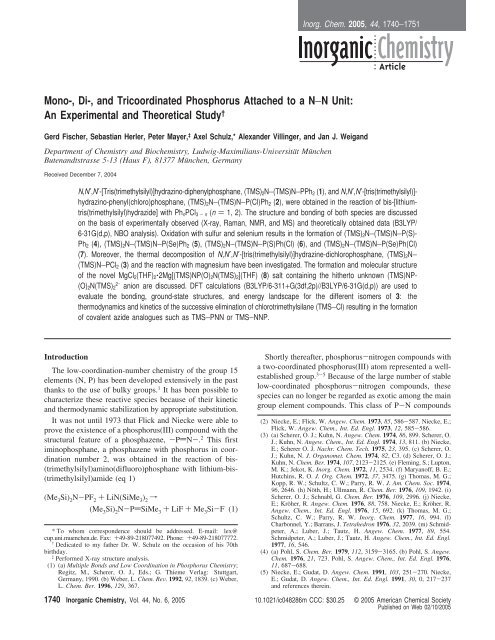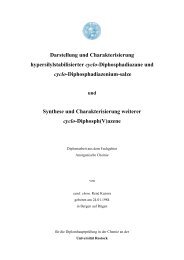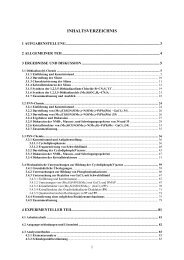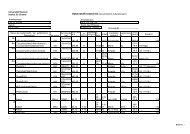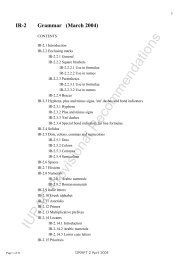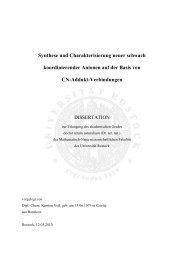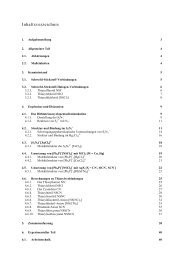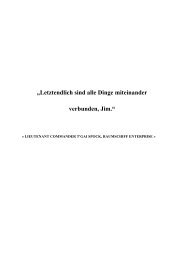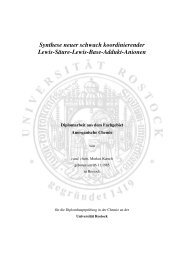Darstellung und Charakterisierung neuer niedrigkoordinierter ...
Darstellung und Charakterisierung neuer niedrigkoordinierter ...
Darstellung und Charakterisierung neuer niedrigkoordinierter ...
Create successful ePaper yourself
Turn your PDF publications into a flip-book with our unique Google optimized e-Paper software.
Mono-, Di-, and Tricoordinated Phosphorus Attached to a N−N Unit:<br />
An Experimental and Theoretical Study †<br />
Gerd Fischer, Sebastian Herler, Peter Mayer, ‡ Axel Schulz,* Alexander Villinger, and Jan J. Weigand<br />
Department of Chemistry and Biochemistry, Ludwig-Maximilians-UniVersität München<br />
Butenandtstrasse 5-13 (Haus F), 81377 München, Germany<br />
Received December 7, 2004<br />
Introduction<br />
N,N′,N′-[Tris(trimethylsilyl)]hydrazino-diphenylphosphane, (TMS)2N−(TMS)N−PPh2 (1), and N,N′,N′-[tris(trimethylsilyl)]hydrazino-phenyl(chloro)phosphane,<br />
(TMS)2N−(TMS)N−P(Cl)Ph2 (2), were obtained in the reaction of bis-[lithiumtris(trimethylsilyl)hydrazide]<br />
with PhnPCl3-n (n ) 1, 2). The structure and bonding of both species are discussed<br />
on the basis of experimentally observed (X-ray, Raman, NMR, and MS) and theoretically obtained data (B3LYP/<br />
6-31G(d,p), NBO analysis). Oxidation with sulfur and selenium results in the formation of (TMS)2N−(TMS)N−P(S)-<br />
Ph2 (4), (TMS)2N−(TMS)N−P(Se)Ph2 (5), (TMS)2N−(TMS)N−P(S)Ph(Cl) (6), and (TMS)2N−(TMS)N−P(Se)Ph(Cl)<br />
(7). Moreover, the thermal decomposition of N,N′,N′-[tris(trimethylsilyl)]hydrazine-dichlorophosphane, (TMS)2N−<br />
(TMS)N−PCl2 (3) and the reaction with magnesium have been investigated. The formation and molecular structure<br />
of the novel MgCl2(THF)2‚2Mg[(TMS)NP(O)2N(TMS)2](THF) (8) salt containing the hitherto unknown (TMS)NP-<br />
(O)2N(TMS)2 2− anion are discussed. DFT calculations (B3LYP/6-311+G(3df,2p)//B3LYP/6-31G(d,p)) are used to<br />
evaluate the bonding, gro<strong>und</strong>-state structures, and energy landscape for the different isomers of 3: the<br />
thermodynamics and kinetics of the successive elimination of chlorotrimethylsilane (TMS−Cl) resulting in the formation<br />
of covalent azide analogues such as TMS−PNN or TMS−NNP.<br />
The low-coordination-number chemistry of the group 15<br />
elements (N, P) has been developed extensively in the past<br />
thanks to the use of bulky groups. 1 It has been possible to<br />
characterize these reactive species because of their kinetic<br />
and thermodynamic stabilization by appropriate substitution.<br />
It was not until 1973 that Flick and Niecke were able to<br />
prove the existence of a phosphorus(III) compo<strong>und</strong> with the<br />
structural feature of a phosphazene, -PdN-. 2 This first<br />
iminophosphane, a phosphazene with phosphorus in coordination<br />
number 2, was obtained in the reaction of bis-<br />
(trimethylsilyl)amino(difluoro)phosphane with lithium-bis-<br />
(trimethylsilyl)amide (eq 1)<br />
(Me 3 Si) 2 N-PF 2 + LiN(SiMe 3 ) 2 f<br />
(Me 3 Si) 2 N-PdSiMe 3 + LiF + Me 3 Si-F (1)<br />
* To whom correspondence should be addressed. E-mail: lex@<br />
cup.uni.muenchen.de. Fax: +49-89-218077492. Phone: +49-89-218077772.<br />
† Dedicated to my father Dr. W. Schulz on the occasion of his 70th<br />
birthday.<br />
‡ Performed X-ray structure analysis.<br />
(1) (a) Multiple Bonds and Low Coordination in Phosphorus Chemistry;<br />
Regitz, M., Scherer, O. J., Eds.; G. Thieme Verlag: Stuttgart,<br />
Germany, 1990. (b) Weber, L. Chem. ReV. 1992, 92, 1839. (c) Weber,<br />
L. Chem. Ber. 1996, 129, 367.<br />
Inorg. Chem. 2005, 44, 1740−1751<br />
Shortly thereafter, phosphorus-nitrogen compo<strong>und</strong>s with<br />
a two-coordinated phosphorus(III) atom represented a wellestablished<br />
group. 3-5 Because of the large number of stable<br />
low-coordinated phosphorus-nitrogen compo<strong>und</strong>s, these<br />
species can no longer be regarded as exotic among the main<br />
group element compo<strong>und</strong>s. This class of P-N compo<strong>und</strong>s<br />
(2) Niecke, E.; Flick, W. Angew. Chem. 1973, 85, 586-587. Niecke, E.;<br />
Flick, W. Angew. Chem., Int. Ed. Engl. 1973, 12, 585-586.<br />
(3) (a) Scherer, O. J.; Kuhn, N. Angew. Chem. 1974, 86, 899. Scherer, O.<br />
J.; Kuhn, N. Angew. Chem., Int. Ed. Engl. 1974, 13, 811. (b) Niecke,<br />
E.; Scherer O. J. Nachr. Chem. Tech. 1975, 23, 395. (c) Scherer, O.<br />
J.; Kuhn, N. J. Organomet. Chem. 1974, 82, C3. (d) Scherer, O. J.;<br />
Kuhn, N. Chem. Ber. 1974, 107, 2123-2125. (e) Fleming, S.; Lupton,<br />
M. K.; Jekot, K. Inorg. Chem. 1972, 11, 2534. (f) Maryanoff, B. E.;<br />
Hutchins, R. O. J. Org. Chem. 1972, 37, 3475. (g) Thomas, M. G.;<br />
Kopp, R. W.; Schultz, C. W.; Parry, R. W. J. Am. Chem. Soc. 1974,<br />
96, 2646. (h) Nöth, H.; Ullmann, R. Chem. Ber. 1976, 109, 1942. (i)<br />
Scherer, O. J.; Schnabl, G. Chem. Ber. 1976, 109, 2996. (j) Niecke,<br />
E.; Kröher, R. Angew. Chem. 1976, 88, 758. Niecke, E.; Kröher, R.<br />
Angew. Chem., Int. Ed. Engl. 1976, 15, 692. (k) Thomas, M. G.;<br />
Schultz, C. W.; Parry, R. W. Inorg. Chem. 1977, 16, 994. (l)<br />
Charbonnel, Y.; Barrans, J. Tetrahedron 1976, 32, 2039. (m) Schmidpeter,<br />
A.; Luber, J.; Tautz, H. Angew. Chem. 1977, 89, 554.<br />
Schmidpeter, A.; Luber, J.; Tautz, H. Angew. Chem., Int. Ed. Engl.<br />
1977, 16, 546.<br />
(4) (a) Pohl, S. Chem. Ber. 1979, 112, 3159-3165. (b) Pohl, S. Angew.<br />
Chem. 1976, 21, 723. Pohl, S. Angew. Chem., Int. Ed. Engl. 1976,<br />
11, 687-688.<br />
(5) Niecke, E.; Gudat, D. Angew. Chem. 1991, 103, 251-270. Niecke,<br />
E.; Gudat, D. Angew. Chem., Int. Ed. Engl. 1991, 30, 0,217-237<br />
and references therein.<br />
1740 Inorganic Chemistry, Vol. 44, No. 6, 2005 10.1021/ic048286m CCC: $30.25 © 2005 American Chemical Society<br />
Published on Web 02/10/2005


